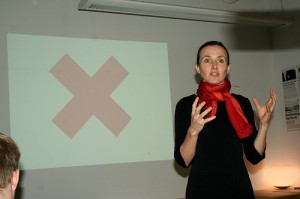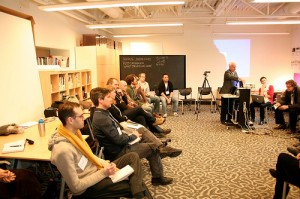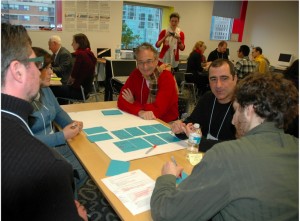Natalie Jeremijenko, the founder of the xCLINIC was in Toronto to attend xCAMP. She was invited by OCAD’s Strategic Innovation Lab (sLab) to present her current research in the context of sLab’s Exploration series. She titled her talk “Post Copenhagen: What Strategies Now?” She argued that with the failure of the super-conference format of the Copenhagen negotiations, the emphasis now falls on other strategies and technological opportunities to raise the standard of evidence and coordinate a more diverse response to environmental challenges. She asked how can distributed sensing and public sharing of data reveal this evidence? How can it support and enable local organization and actions?And how can social networking be used in collective sense-making and life-style experiments to localize responsibility for environmental health?

Regardless how familiar you are with Jeremijenko’s work, you are guaranteed to discover something new and fascinating every time she speaks about her research. This well attended Explorations event was no exception and the ensuing discussion was the perfect preamble to xCAMP that immediately followed.
As organizers of xCAMP we were overwhelmed by and grateful for the interest and support extended to us. Participants brought an amazing scope of knowledge and experience to bear on the issues discussed at xCAMP. The agenda consisted of 3 main segments. In the first segment Natalie presented the xCLINIC concept and showed examples of her related activities. Then Carla Gould from the core organizing group presented a storyboard illustrating the “impatient’s” experience. She was followed by Nabil Harfoush, who took participants through xCLINIC’s foundational elements, their strengths and weaknesses, and proposed a framework for xCLINIC 2.0 aiming at establishing a movement around many xCLINICs.

Open Circle
The second segment consisted of an open circle discussion of the proposed concept followed by 5 break-out sessions that handled:
- The Starter Kit
- Creative Engagement
- Collaboration & Communications
- Alliances & Central Resources
- Benchmarks & Impact Measurements
The break-out sessions were facilitated by a wonderful team: Pam Purves, Greg Judelman, Ryan Coleman, Dan Rose, and Magda Wesolkowska, all of whom are colleagues and friends from the Design with Dialogue collective. We are grateful for their assistance and dedication.

The final segment (called Harvest) consisted of a “market place” type of exchange, where participants circulated among the displayed findings of the 5 break-out groups and added their thoughts and comments, a brief presentations by each group, and a general discussion about findings.
xCAMP generated a significant volume of ideas, solutions and activities road map, which were captured in a variety of ways including flip charts, sticky-note collections, photos and video recording.We have started the arduous task of processing all these outcomes and will be reporting on progress regularly.

Our plans call for establishing 5 permanent working groups to continue working on this project. If you are interested in participating send an email to xclinic@www.manara.ca with a description of your interest areas and degree of availability for participating in any one of these groups.
 I had the pleasure of being interviewed by
I had the pleasure of being interviewed by 


